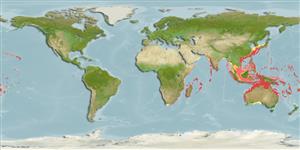Environment: milieu / climate zone / depth range / distribution range
Ecologia
marinhas associadas(os) a recifes; intervalo de profundidade 4 - 131 m (Ref. 9710), usually 9 - 130 m (Ref. 27115). Tropical; 24°C - 28°C (Ref. 27115); 40°N - 37°S, 17°E - 155°W
Indo-Pacific: East Africa (including the Mascarene Islands, Ref. 37792) to the Hawaiian and Line islands, north to southern Japan, south to Rowley Shoals, southern Great Barrier Reef and Lord Howe Island. Absent from most of central Pacific.
Tamanho / Peso / Idade
Maturity: Lm ? range ? - ? cm
Max length : 54.0 cm TL macho/indeterminado; (Ref. 3145); common length : 35.0 cm TL macho/indeterminado; (Ref. 3146); idade máx. registrada: 30 anos (Ref. 127555)
Espinhos dorsais (total): 9; Raios dorsais (total): 25-27; Espinhos anais 3; Raios anais : 24 - 26. Pale brown body; broader, irregular lines on head; orange band between eyes, continued behind each eye to gill cover. Each side of caudal peduncle with single, sharp, forward-pointing erectile spine; spine largely covered by cream sheath; groove surrounded by a black area. Dorsal fin with soft part having longer base than spinous part. Minute scales. Gill rakers 22-26 in anterior row, 23-27 in posterior row. Caudal fin lunate in adults (Ref. 1602).
Schooling species, usually occurring in seaward reefs at depths greater than 9 m (Ref. 1602). Adults mainly on deep coastal reef slopes and outer reef walls, often on deep shipwrecks. Juveniles found on algae-rocky reef (Ref. 48637). Benthopelagic (Ref. 58302). Occur singly or in groups (Ref. 37816). Feed on surface film of fine green and blue-green algae, diatoms, and detritus covering sand (Ref. 1602). Pair-spawner (Ref. 37816). Mainly diurnal. (Ref. 1602). Utilized as a food fish (Ref. 3146).
Ciclo de vida ou comportamento de acasalamento
Maturidade | Reprodução | Desova | Ovos | Fecundidade | Larvas
Probably spawn in pairs (Ref. 240).
Randall, J.E., 1986. Acanthuridae. p. 811-823. In M.M. Smith and P.C. Heemstra (eds.) Smiths' sea fishes. Springer-Verlag, Berlin. (Ref. 3145)
Status na Lista Vermelha da UICN (Ref. 130435)
Uso pelos humanos
Pescarias: pouco comercial; Aquário: Espécies comerciais
Mais informação
ReferênciasAquaculturaPerfil para aquaculturaEstirpesGenéticaElectrophoresesHereditariedadeDoençasProcessamentoNutrientsConversão de massa
Ferramentas
Relatórios especiais
Baixar XML
Fontes da internet
Estimates based on models
Preferred temperature (Ref.
123201): 20.3 - 28.9, mean 27.2 °C (based on 2904 cells).
Índice de diversidade filogenética (Ref.
82804): PD
50 = 0.5000 [Uniqueness, from 0.5 = low to 2.0 = high].
Bayesian length-weight: a=0.03020 (0.01872 - 0.04873), b=2.94 (2.80 - 3.08), in cm total length, based on LWR estimates for this species & Genus-body shape (Ref.
93245).
Nível Trófico (Ref.
69278): 2.0 ±0.00 se; based on food items.
Generation time: 3.7 ( na - na) years. Estimated as median ln(3)/K based on 1
growth studies.
Resiliência (Ref.
120179): Baixo, tempo mínimo de duplicação da população 4,5 - 14 anos (tmax=28; K=0.29).
Fishing Vulnerability (Ref.
59153): Moderate vulnerability (36 of 100).
Nutrients (Ref.
124155): Calcium = 40.3 [16.1, 111.2] mg/100g; Iron = 0.653 [0.253, 1.583] mg/100g; Protein = 18.2 [16.8, 19.4] %; Omega3 = 0.105 [0.048, 0.219] g/100g; Selenium = 25.9 [8.9, 76.2] μg/100g; VitaminA = 31 [7, 131] μg/100g; Zinc = 2.38 [0.75, 4.33] mg/100g (wet weight);
